Commercial Law Report: Thermomix Liability and Australian Consumer Law
VerifiedAdded on 2020/11/12
|10
|2787
|98
Report
AI Summary
This report delves into the commercial law aspects of Thermomix appliance liability in Australia, focusing on negligence, product defects, and consumer rights under the Australian Consumer Law (ACL). It examines the basis of liability for manufacturers and distributors, highlighting the duty of care owed to consumers and the potential for product liability claims. The report discusses the role of caps on personal injury damages and the rights of injured users under the ACL, including statutory guarantees and remedies for defective products. It analyzes relevant case law, such as Grant v Australian Knitting Mills and Donoghue v Stevenson, to illustrate the legal principles involved. The report also explores the potential for consumers to file complaints and lawsuits against both manufacturers and importers, and their entitlement to compensation for personal injuries caused by defective products, emphasizing the ACL's provisions for consumer protection and remedies, including refunds, repairs, or replacements.
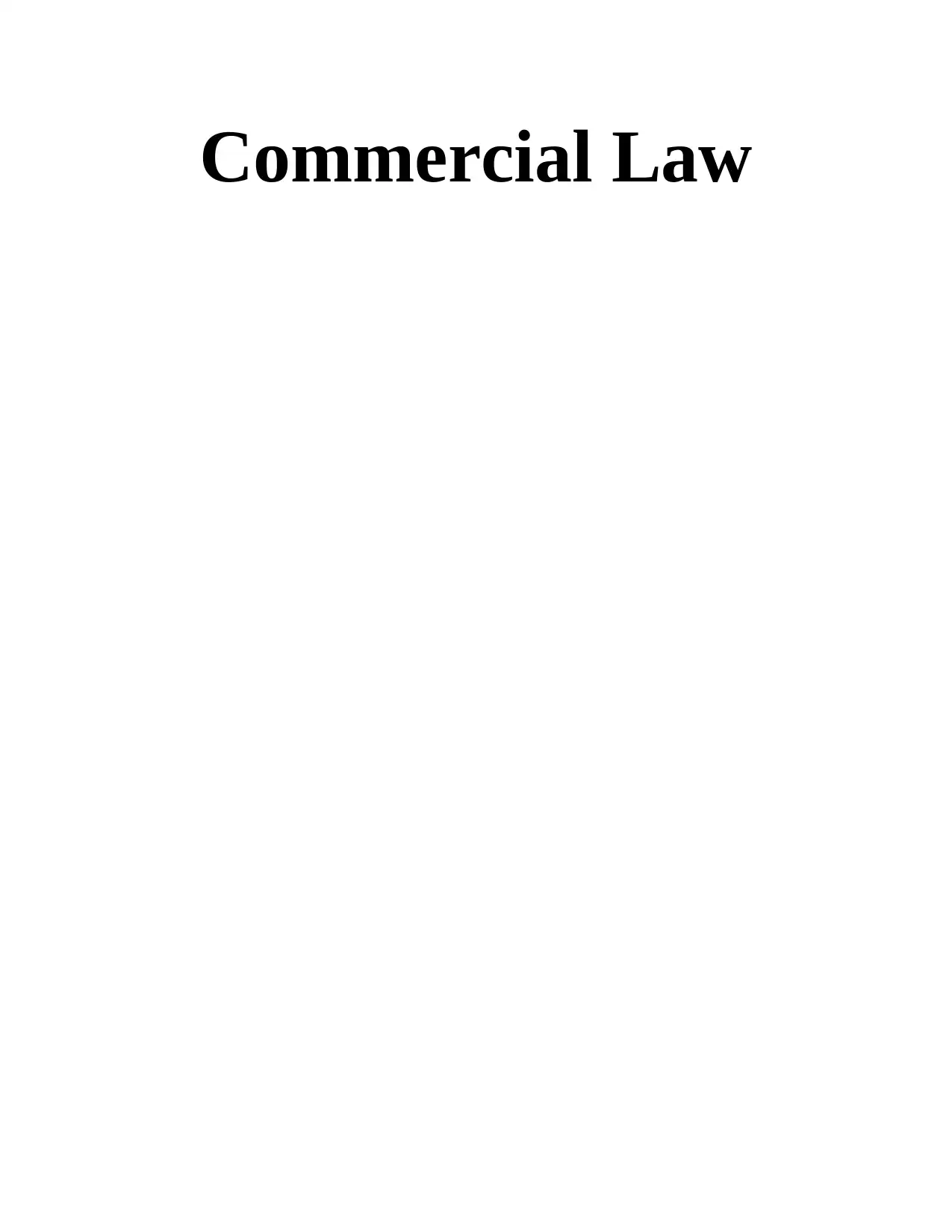
Commercial Law
Paraphrase This Document
Need a fresh take? Get an instant paraphrase of this document with our AI Paraphraser
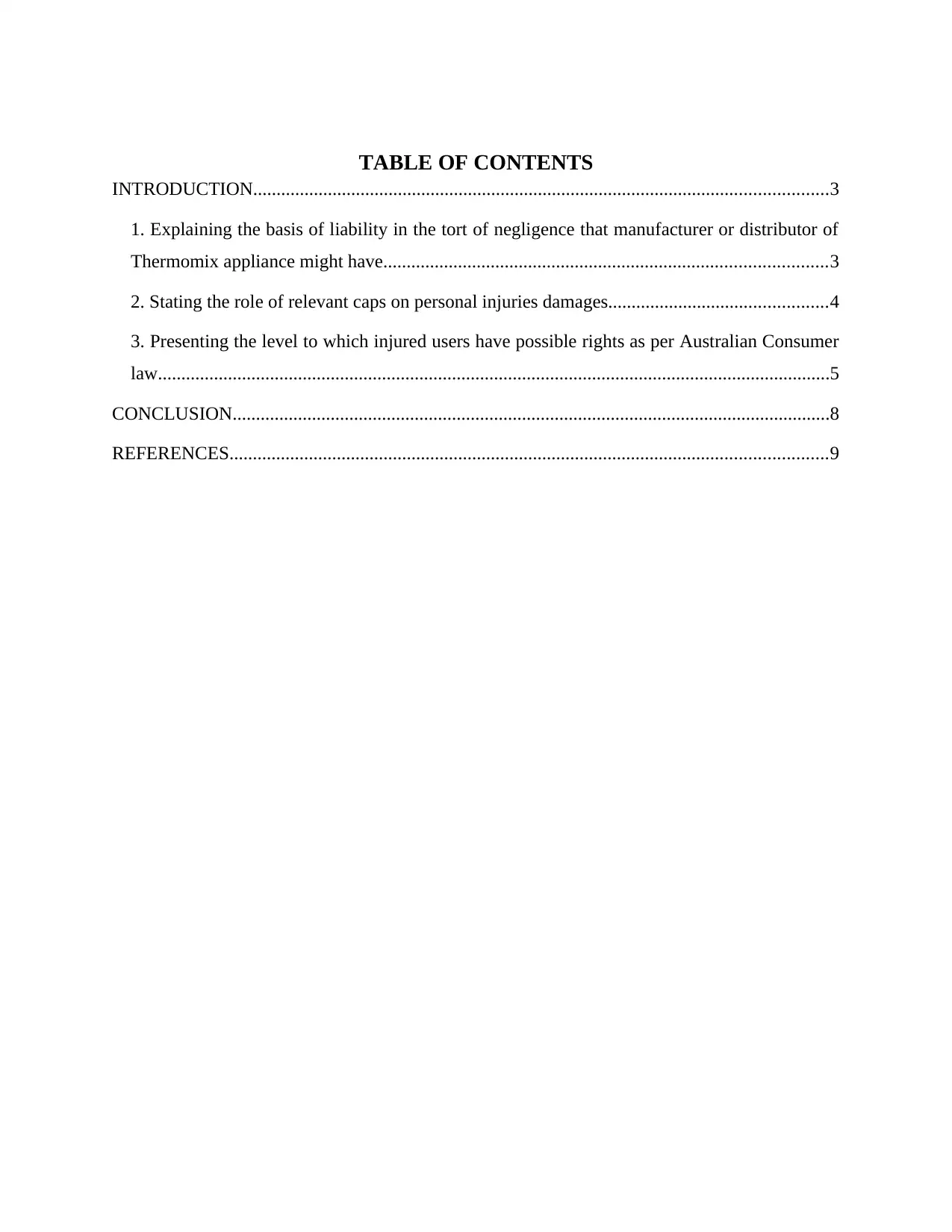
TABLE OF CONTENTS
INTRODUCTION...........................................................................................................................3
1. Explaining the basis of liability in the tort of negligence that manufacturer or distributor of
Thermomix appliance might have...............................................................................................3
2. Stating the role of relevant caps on personal injuries damages...............................................4
3. Presenting the level to which injured users have possible rights as per Australian Consumer
law................................................................................................................................................5
CONCLUSION................................................................................................................................8
REFERENCES................................................................................................................................9
INTRODUCTION...........................................................................................................................3
1. Explaining the basis of liability in the tort of negligence that manufacturer or distributor of
Thermomix appliance might have...............................................................................................3
2. Stating the role of relevant caps on personal injuries damages...............................................4
3. Presenting the level to which injured users have possible rights as per Australian Consumer
law................................................................................................................................................5
CONCLUSION................................................................................................................................8
REFERENCES................................................................................................................................9
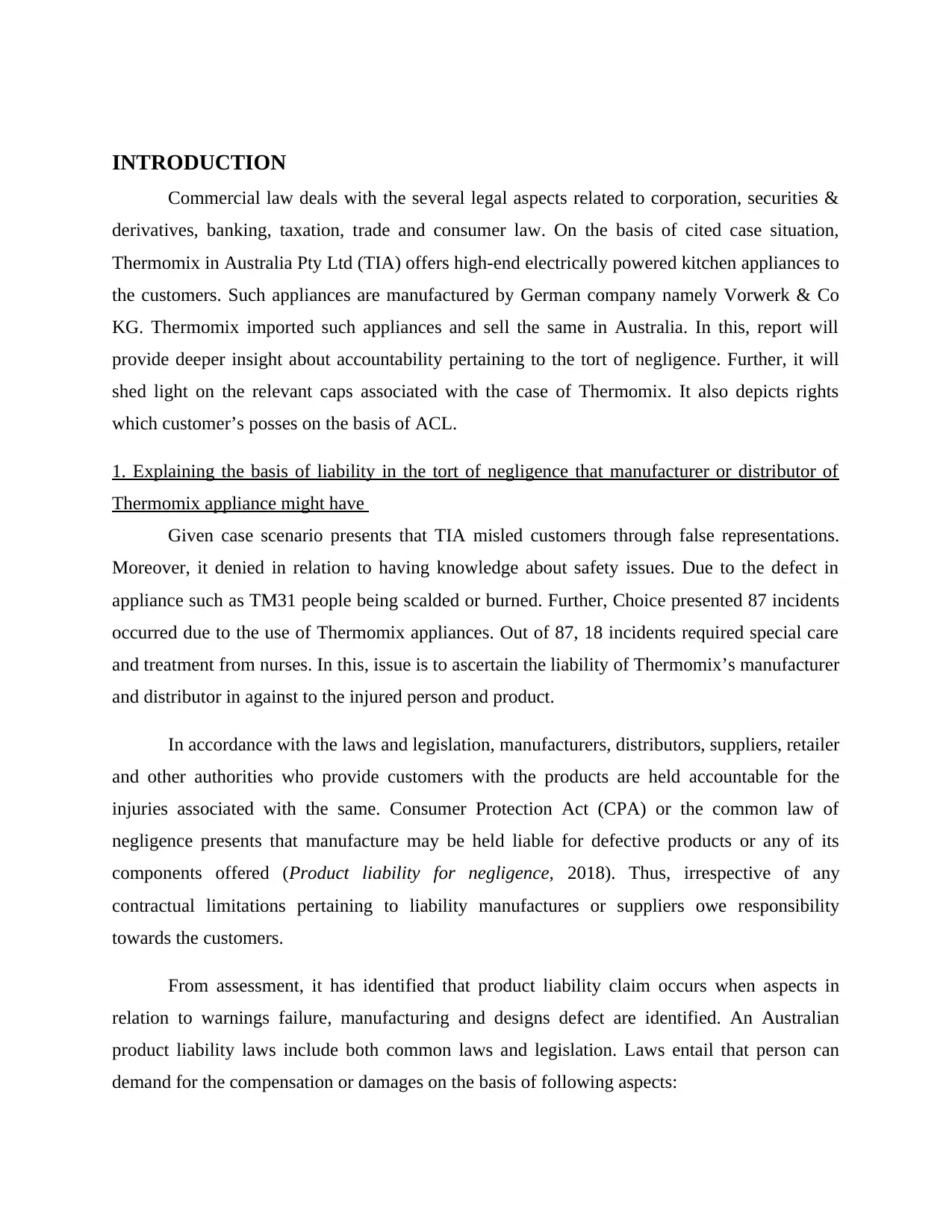
INTRODUCTION
Commercial law deals with the several legal aspects related to corporation, securities &
derivatives, banking, taxation, trade and consumer law. On the basis of cited case situation,
Thermomix in Australia Pty Ltd (TIA) offers high-end electrically powered kitchen appliances to
the customers. Such appliances are manufactured by German company namely Vorwerk & Co
KG. Thermomix imported such appliances and sell the same in Australia. In this, report will
provide deeper insight about accountability pertaining to the tort of negligence. Further, it will
shed light on the relevant caps associated with the case of Thermomix. It also depicts rights
which customer’s posses on the basis of ACL.
1. Explaining the basis of liability in the tort of negligence that manufacturer or distributor of
Thermomix appliance might have
Given case scenario presents that TIA misled customers through false representations.
Moreover, it denied in relation to having knowledge about safety issues. Due to the defect in
appliance such as TM31 people being scalded or burned. Further, Choice presented 87 incidents
occurred due to the use of Thermomix appliances. Out of 87, 18 incidents required special care
and treatment from nurses. In this, issue is to ascertain the liability of Thermomix’s manufacturer
and distributor in against to the injured person and product.
In accordance with the laws and legislation, manufacturers, distributors, suppliers, retailer
and other authorities who provide customers with the products are held accountable for the
injuries associated with the same. Consumer Protection Act (CPA) or the common law of
negligence presents that manufacture may be held liable for defective products or any of its
components offered (Product liability for negligence, 2018). Thus, irrespective of any
contractual limitations pertaining to liability manufactures or suppliers owe responsibility
towards the customers.
From assessment, it has identified that product liability claim occurs when aspects in
relation to warnings failure, manufacturing and designs defect are identified. An Australian
product liability laws include both common laws and legislation. Laws entail that person can
demand for the compensation or damages on the basis of following aspects:
Commercial law deals with the several legal aspects related to corporation, securities &
derivatives, banking, taxation, trade and consumer law. On the basis of cited case situation,
Thermomix in Australia Pty Ltd (TIA) offers high-end electrically powered kitchen appliances to
the customers. Such appliances are manufactured by German company namely Vorwerk & Co
KG. Thermomix imported such appliances and sell the same in Australia. In this, report will
provide deeper insight about accountability pertaining to the tort of negligence. Further, it will
shed light on the relevant caps associated with the case of Thermomix. It also depicts rights
which customer’s posses on the basis of ACL.
1. Explaining the basis of liability in the tort of negligence that manufacturer or distributor of
Thermomix appliance might have
Given case scenario presents that TIA misled customers through false representations.
Moreover, it denied in relation to having knowledge about safety issues. Due to the defect in
appliance such as TM31 people being scalded or burned. Further, Choice presented 87 incidents
occurred due to the use of Thermomix appliances. Out of 87, 18 incidents required special care
and treatment from nurses. In this, issue is to ascertain the liability of Thermomix’s manufacturer
and distributor in against to the injured person and product.
In accordance with the laws and legislation, manufacturers, distributors, suppliers, retailer
and other authorities who provide customers with the products are held accountable for the
injuries associated with the same. Consumer Protection Act (CPA) or the common law of
negligence presents that manufacture may be held liable for defective products or any of its
components offered (Product liability for negligence, 2018). Thus, irrespective of any
contractual limitations pertaining to liability manufactures or suppliers owe responsibility
towards the customers.
From assessment, it has identified that product liability claim occurs when aspects in
relation to warnings failure, manufacturing and designs defect are identified. An Australian
product liability laws include both common laws and legislation. Laws entail that person can
demand for the compensation or damages on the basis of following aspects:
⊘ This is a preview!⊘
Do you want full access?
Subscribe today to unlock all pages.

Trusted by 1+ million students worldwide
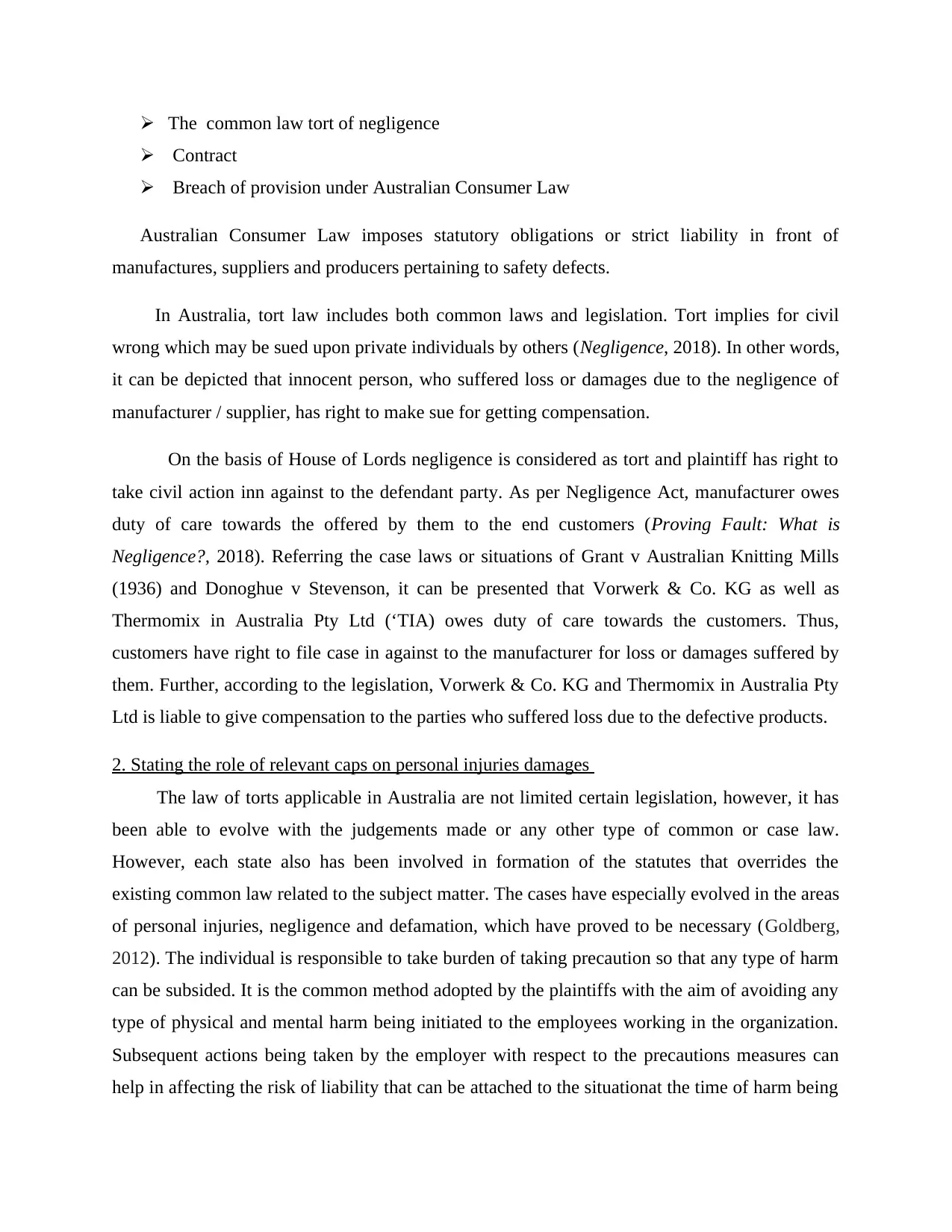
The common law tort of negligence
Contract
Breach of provision under Australian Consumer Law
Australian Consumer Law imposes statutory obligations or strict liability in front of
manufactures, suppliers and producers pertaining to safety defects.
In Australia, tort law includes both common laws and legislation. Tort implies for civil
wrong which may be sued upon private individuals by others (Negligence, 2018). In other words,
it can be depicted that innocent person, who suffered loss or damages due to the negligence of
manufacturer / supplier, has right to make sue for getting compensation.
On the basis of House of Lords negligence is considered as tort and plaintiff has right to
take civil action inn against to the defendant party. As per Negligence Act, manufacturer owes
duty of care towards the offered by them to the end customers (Proving Fault: What is
Negligence?, 2018). Referring the case laws or situations of Grant v Australian Knitting Mills
(1936) and Donoghue v Stevenson, it can be presented that Vorwerk & Co. KG as well as
Thermomix in Australia Pty Ltd (‘TIA) owes duty of care towards the customers. Thus,
customers have right to file case in against to the manufacturer for loss or damages suffered by
them. Further, according to the legislation, Vorwerk & Co. KG and Thermomix in Australia Pty
Ltd is liable to give compensation to the parties who suffered loss due to the defective products.
2. Stating the role of relevant caps on personal injuries damages
The law of torts applicable in Australia are not limited certain legislation, however, it has
been able to evolve with the judgements made or any other type of common or case law.
However, each state also has been involved in formation of the statutes that overrides the
existing common law related to the subject matter. The cases have especially evolved in the areas
of personal injuries, negligence and defamation, which have proved to be necessary (Goldberg,
2012). The individual is responsible to take burden of taking precaution so that any type of harm
can be subsided. It is the common method adopted by the plaintiffs with the aim of avoiding any
type of physical and mental harm being initiated to the employees working in the organization.
Subsequent actions being taken by the employer with respect to the precautions measures can
help in affecting the risk of liability that can be attached to the situationat the time of harm being
Contract
Breach of provision under Australian Consumer Law
Australian Consumer Law imposes statutory obligations or strict liability in front of
manufactures, suppliers and producers pertaining to safety defects.
In Australia, tort law includes both common laws and legislation. Tort implies for civil
wrong which may be sued upon private individuals by others (Negligence, 2018). In other words,
it can be depicted that innocent person, who suffered loss or damages due to the negligence of
manufacturer / supplier, has right to make sue for getting compensation.
On the basis of House of Lords negligence is considered as tort and plaintiff has right to
take civil action inn against to the defendant party. As per Negligence Act, manufacturer owes
duty of care towards the offered by them to the end customers (Proving Fault: What is
Negligence?, 2018). Referring the case laws or situations of Grant v Australian Knitting Mills
(1936) and Donoghue v Stevenson, it can be presented that Vorwerk & Co. KG as well as
Thermomix in Australia Pty Ltd (‘TIA) owes duty of care towards the customers. Thus,
customers have right to file case in against to the manufacturer for loss or damages suffered by
them. Further, according to the legislation, Vorwerk & Co. KG and Thermomix in Australia Pty
Ltd is liable to give compensation to the parties who suffered loss due to the defective products.
2. Stating the role of relevant caps on personal injuries damages
The law of torts applicable in Australia are not limited certain legislation, however, it has
been able to evolve with the judgements made or any other type of common or case law.
However, each state also has been involved in formation of the statutes that overrides the
existing common law related to the subject matter. The cases have especially evolved in the areas
of personal injuries, negligence and defamation, which have proved to be necessary (Goldberg,
2012). The individual is responsible to take burden of taking precaution so that any type of harm
can be subsided. It is the common method adopted by the plaintiffs with the aim of avoiding any
type of physical and mental harm being initiated to the employees working in the organization.
Subsequent actions being taken by the employer with respect to the precautions measures can
help in affecting the risk of liability that can be attached to the situationat the time of harm being
Paraphrase This Document
Need a fresh take? Get an instant paraphrase of this document with our AI Paraphraser
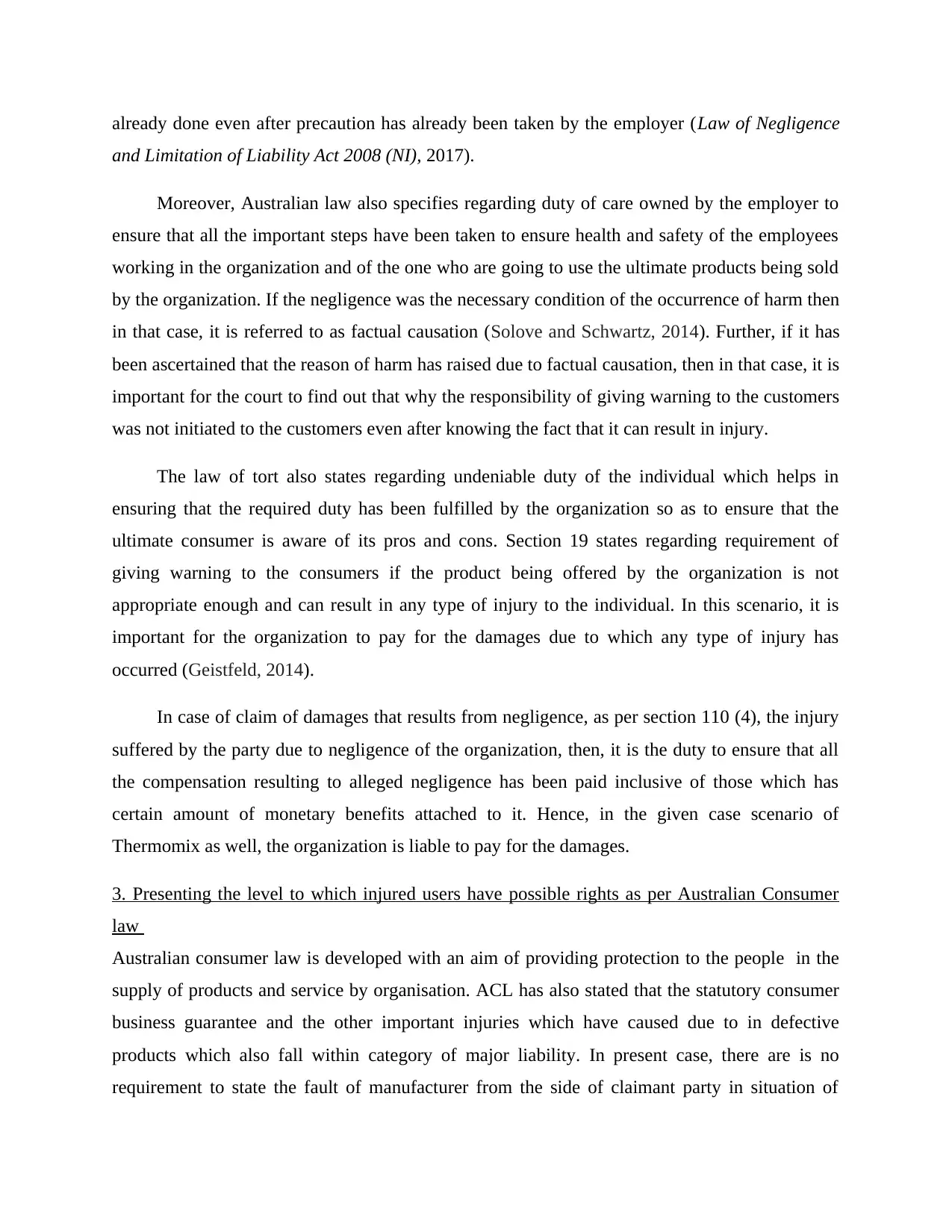
already done even after precaution has already been taken by the employer (Law of Negligence
and Limitation of Liability Act 2008 (NI), 2017).
Moreover, Australian law also specifies regarding duty of care owned by the employer to
ensure that all the important steps have been taken to ensure health and safety of the employees
working in the organization and of the one who are going to use the ultimate products being sold
by the organization. If the negligence was the necessary condition of the occurrence of harm then
in that case, it is referred to as factual causation (Solove and Schwartz, 2014). Further, if it has
been ascertained that the reason of harm has raised due to factual causation, then in that case, it is
important for the court to find out that why the responsibility of giving warning to the customers
was not initiated to the customers even after knowing the fact that it can result in injury.
The law of tort also states regarding undeniable duty of the individual which helps in
ensuring that the required duty has been fulfilled by the organization so as to ensure that the
ultimate consumer is aware of its pros and cons. Section 19 states regarding requirement of
giving warning to the consumers if the product being offered by the organization is not
appropriate enough and can result in any type of injury to the individual. In this scenario, it is
important for the organization to pay for the damages due to which any type of injury has
occurred (Geistfeld, 2014).
In case of claim of damages that results from negligence, as per section 110 (4), the injury
suffered by the party due to negligence of the organization, then, it is the duty to ensure that all
the compensation resulting to alleged negligence has been paid inclusive of those which has
certain amount of monetary benefits attached to it. Hence, in the given case scenario of
Thermomix as well, the organization is liable to pay for the damages.
3. Presenting the level to which injured users have possible rights as per Australian Consumer
law
Australian consumer law is developed with an aim of providing protection to the people in the
supply of products and service by organisation. ACL has also stated that the statutory consumer
business guarantee and the other important injuries which have caused due to in defective
products which also fall within category of major liability. In present case, there are is no
requirement to state the fault of manufacturer from the side of claimant party in situation of
and Limitation of Liability Act 2008 (NI), 2017).
Moreover, Australian law also specifies regarding duty of care owned by the employer to
ensure that all the important steps have been taken to ensure health and safety of the employees
working in the organization and of the one who are going to use the ultimate products being sold
by the organization. If the negligence was the necessary condition of the occurrence of harm then
in that case, it is referred to as factual causation (Solove and Schwartz, 2014). Further, if it has
been ascertained that the reason of harm has raised due to factual causation, then in that case, it is
important for the court to find out that why the responsibility of giving warning to the customers
was not initiated to the customers even after knowing the fact that it can result in injury.
The law of tort also states regarding undeniable duty of the individual which helps in
ensuring that the required duty has been fulfilled by the organization so as to ensure that the
ultimate consumer is aware of its pros and cons. Section 19 states regarding requirement of
giving warning to the consumers if the product being offered by the organization is not
appropriate enough and can result in any type of injury to the individual. In this scenario, it is
important for the organization to pay for the damages due to which any type of injury has
occurred (Geistfeld, 2014).
In case of claim of damages that results from negligence, as per section 110 (4), the injury
suffered by the party due to negligence of the organization, then, it is the duty to ensure that all
the compensation resulting to alleged negligence has been paid inclusive of those which has
certain amount of monetary benefits attached to it. Hence, in the given case scenario of
Thermomix as well, the organization is liable to pay for the damages.
3. Presenting the level to which injured users have possible rights as per Australian Consumer
law
Australian consumer law is developed with an aim of providing protection to the people in the
supply of products and service by organisation. ACL has also stated that the statutory consumer
business guarantee and the other important injuries which have caused due to in defective
products which also fall within category of major liability. In present case, there are is no
requirement to state the fault of manufacturer from the side of claimant party in situation of
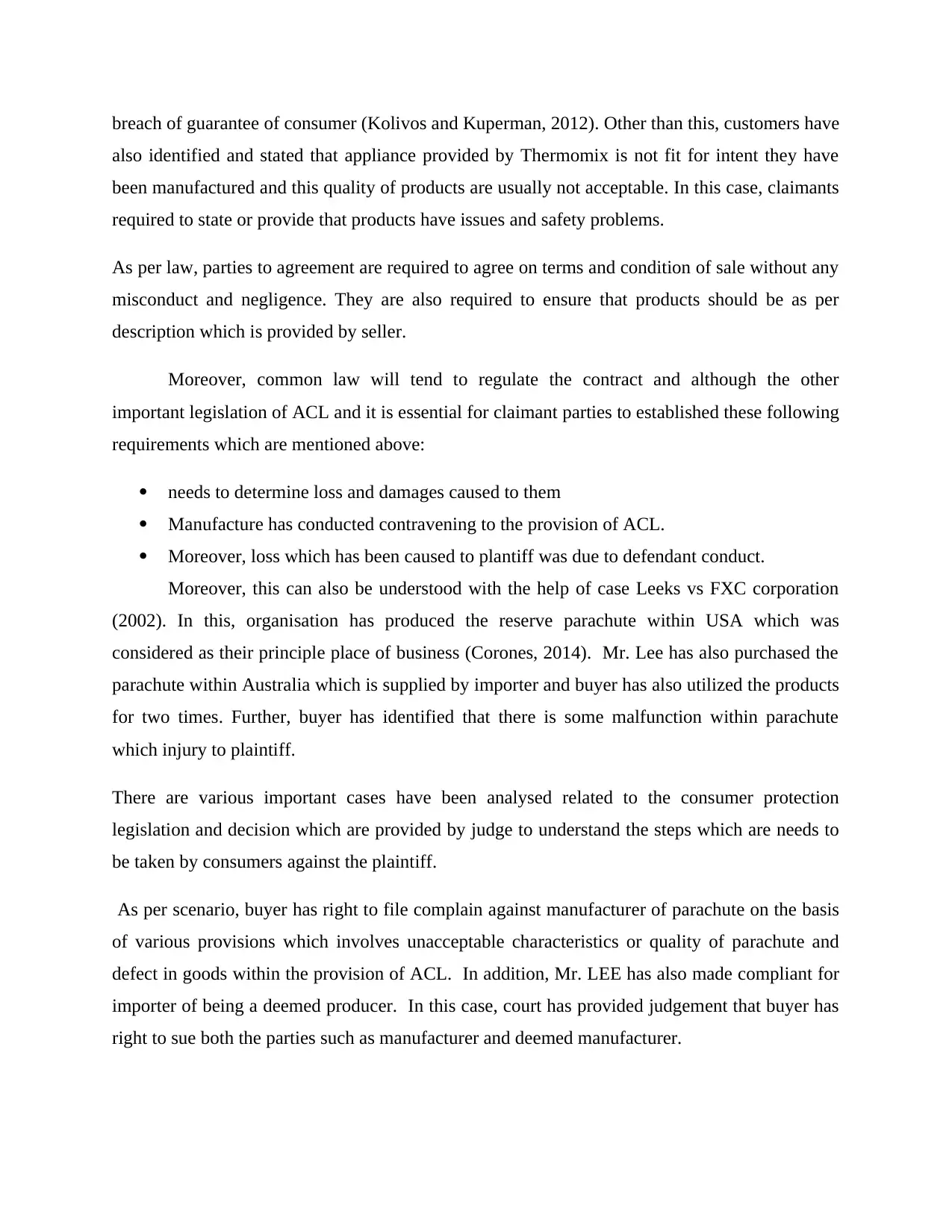
breach of guarantee of consumer (Kolivos and Kuperman, 2012). Other than this, customers have
also identified and stated that appliance provided by Thermomix is not fit for intent they have
been manufactured and this quality of products are usually not acceptable. In this case, claimants
required to state or provide that products have issues and safety problems.
As per law, parties to agreement are required to agree on terms and condition of sale without any
misconduct and negligence. They are also required to ensure that products should be as per
description which is provided by seller.
Moreover, common law will tend to regulate the contract and although the other
important legislation of ACL and it is essential for claimant parties to established these following
requirements which are mentioned above:
needs to determine loss and damages caused to them
Manufacture has conducted contravening to the provision of ACL.
Moreover, loss which has been caused to plantiff was due to defendant conduct.
Moreover, this can also be understood with the help of case Leeks vs FXC corporation
(2002). In this, organisation has produced the reserve parachute within USA which was
considered as their principle place of business (Corones, 2014). Mr. Lee has also purchased the
parachute within Australia which is supplied by importer and buyer has also utilized the products
for two times. Further, buyer has identified that there is some malfunction within parachute
which injury to plaintiff.
There are various important cases have been analysed related to the consumer protection
legislation and decision which are provided by judge to understand the steps which are needs to
be taken by consumers against the plaintiff.
As per scenario, buyer has right to file complain against manufacturer of parachute on the basis
of various provisions which involves unacceptable characteristics or quality of parachute and
defect in goods within the provision of ACL. In addition, Mr. LEE has also made compliant for
importer of being a deemed producer. In this case, court has provided judgement that buyer has
right to sue both the parties such as manufacturer and deemed manufacturer.
also identified and stated that appliance provided by Thermomix is not fit for intent they have
been manufactured and this quality of products are usually not acceptable. In this case, claimants
required to state or provide that products have issues and safety problems.
As per law, parties to agreement are required to agree on terms and condition of sale without any
misconduct and negligence. They are also required to ensure that products should be as per
description which is provided by seller.
Moreover, common law will tend to regulate the contract and although the other
important legislation of ACL and it is essential for claimant parties to established these following
requirements which are mentioned above:
needs to determine loss and damages caused to them
Manufacture has conducted contravening to the provision of ACL.
Moreover, loss which has been caused to plantiff was due to defendant conduct.
Moreover, this can also be understood with the help of case Leeks vs FXC corporation
(2002). In this, organisation has produced the reserve parachute within USA which was
considered as their principle place of business (Corones, 2014). Mr. Lee has also purchased the
parachute within Australia which is supplied by importer and buyer has also utilized the products
for two times. Further, buyer has identified that there is some malfunction within parachute
which injury to plaintiff.
There are various important cases have been analysed related to the consumer protection
legislation and decision which are provided by judge to understand the steps which are needs to
be taken by consumers against the plaintiff.
As per scenario, buyer has right to file complain against manufacturer of parachute on the basis
of various provisions which involves unacceptable characteristics or quality of parachute and
defect in goods within the provision of ACL. In addition, Mr. LEE has also made compliant for
importer of being a deemed producer. In this case, court has provided judgement that buyer has
right to sue both the parties such as manufacturer and deemed manufacturer.
⊘ This is a preview!⊘
Do you want full access?
Subscribe today to unlock all pages.

Trusted by 1+ million students worldwide
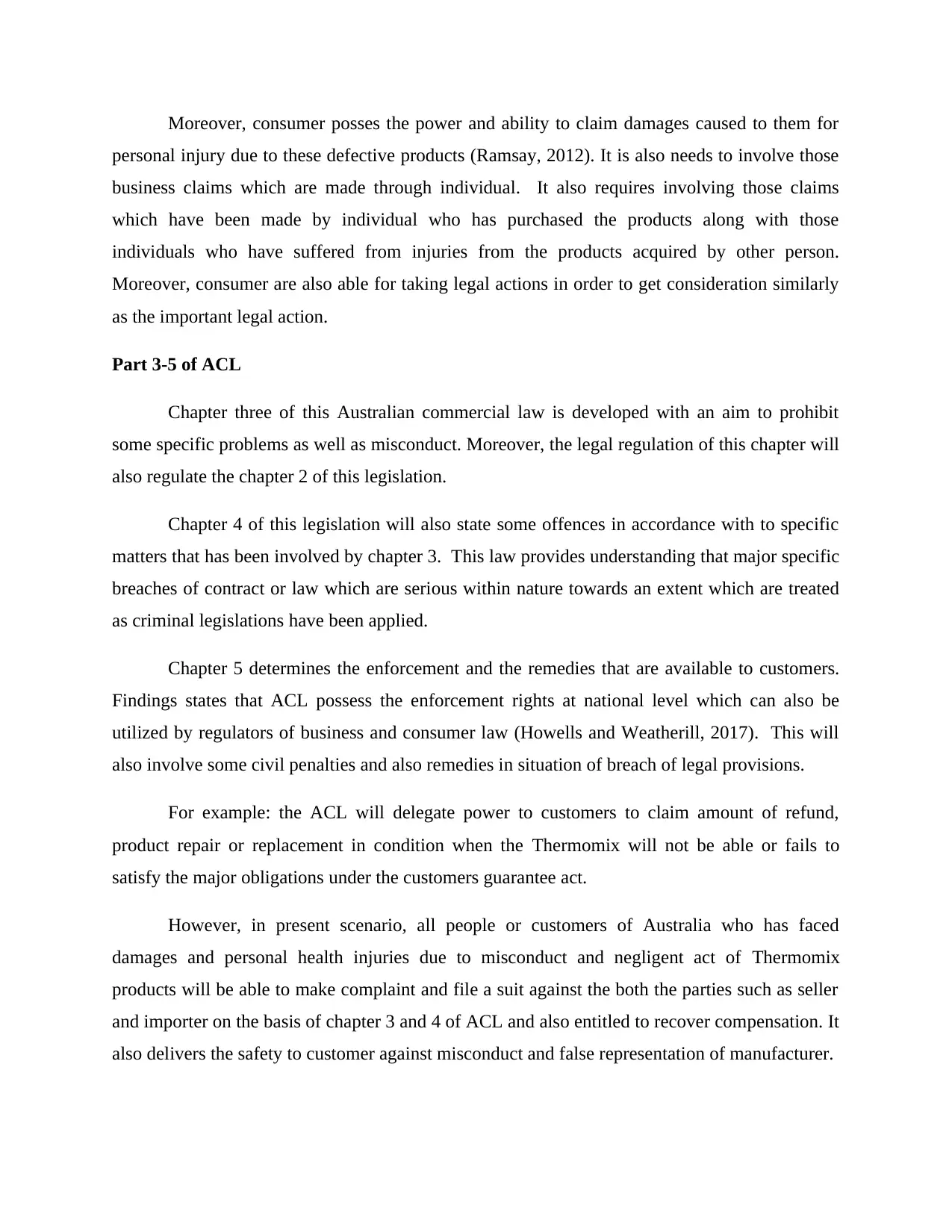
Moreover, consumer posses the power and ability to claim damages caused to them for
personal injury due to these defective products (Ramsay, 2012). It is also needs to involve those
business claims which are made through individual. It also requires involving those claims
which have been made by individual who has purchased the products along with those
individuals who have suffered from injuries from the products acquired by other person.
Moreover, consumer are also able for taking legal actions in order to get consideration similarly
as the important legal action.
Part 3-5 of ACL
Chapter three of this Australian commercial law is developed with an aim to prohibit
some specific problems as well as misconduct. Moreover, the legal regulation of this chapter will
also regulate the chapter 2 of this legislation.
Chapter 4 of this legislation will also state some offences in accordance with to specific
matters that has been involved by chapter 3. This law provides understanding that major specific
breaches of contract or law which are serious within nature towards an extent which are treated
as criminal legislations have been applied.
Chapter 5 determines the enforcement and the remedies that are available to customers.
Findings states that ACL possess the enforcement rights at national level which can also be
utilized by regulators of business and consumer law (Howells and Weatherill, 2017). This will
also involve some civil penalties and also remedies in situation of breach of legal provisions.
For example: the ACL will delegate power to customers to claim amount of refund,
product repair or replacement in condition when the Thermomix will not be able or fails to
satisfy the major obligations under the customers guarantee act.
However, in present scenario, all people or customers of Australia who has faced
damages and personal health injuries due to misconduct and negligent act of Thermomix
products will be able to make complaint and file a suit against the both the parties such as seller
and importer on the basis of chapter 3 and 4 of ACL and also entitled to recover compensation. It
also delivers the safety to customer against misconduct and false representation of manufacturer.
personal injury due to these defective products (Ramsay, 2012). It is also needs to involve those
business claims which are made through individual. It also requires involving those claims
which have been made by individual who has purchased the products along with those
individuals who have suffered from injuries from the products acquired by other person.
Moreover, consumer are also able for taking legal actions in order to get consideration similarly
as the important legal action.
Part 3-5 of ACL
Chapter three of this Australian commercial law is developed with an aim to prohibit
some specific problems as well as misconduct. Moreover, the legal regulation of this chapter will
also regulate the chapter 2 of this legislation.
Chapter 4 of this legislation will also state some offences in accordance with to specific
matters that has been involved by chapter 3. This law provides understanding that major specific
breaches of contract or law which are serious within nature towards an extent which are treated
as criminal legislations have been applied.
Chapter 5 determines the enforcement and the remedies that are available to customers.
Findings states that ACL possess the enforcement rights at national level which can also be
utilized by regulators of business and consumer law (Howells and Weatherill, 2017). This will
also involve some civil penalties and also remedies in situation of breach of legal provisions.
For example: the ACL will delegate power to customers to claim amount of refund,
product repair or replacement in condition when the Thermomix will not be able or fails to
satisfy the major obligations under the customers guarantee act.
However, in present scenario, all people or customers of Australia who has faced
damages and personal health injuries due to misconduct and negligent act of Thermomix
products will be able to make complaint and file a suit against the both the parties such as seller
and importer on the basis of chapter 3 and 4 of ACL and also entitled to recover compensation. It
also delivers the safety to customer against misconduct and false representation of manufacturer.
Paraphrase This Document
Need a fresh take? Get an instant paraphrase of this document with our AI Paraphraser
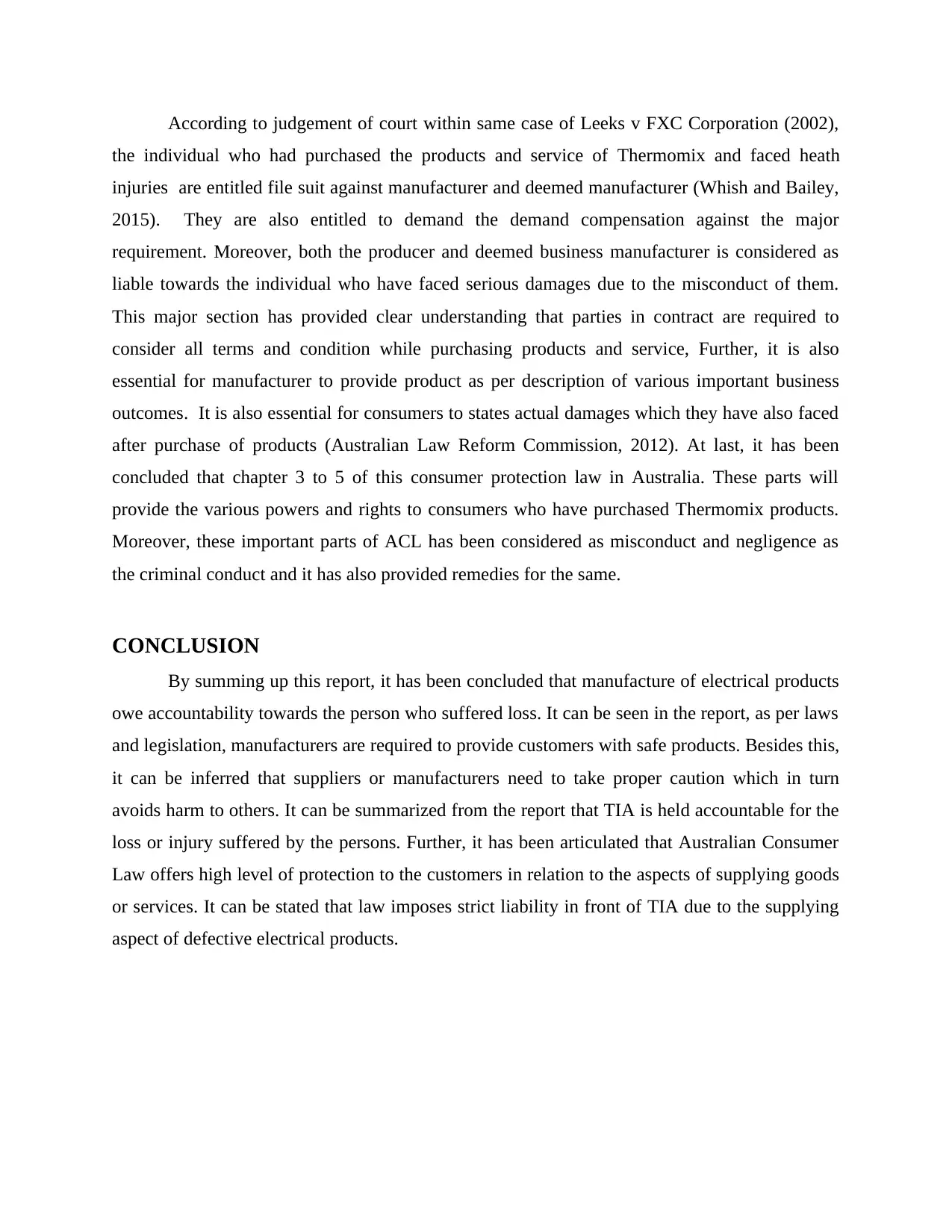
According to judgement of court within same case of Leeks v FXC Corporation (2002),
the individual who had purchased the products and service of Thermomix and faced heath
injuries are entitled file suit against manufacturer and deemed manufacturer (Whish and Bailey,
2015). They are also entitled to demand the demand compensation against the major
requirement. Moreover, both the producer and deemed business manufacturer is considered as
liable towards the individual who have faced serious damages due to the misconduct of them.
This major section has provided clear understanding that parties in contract are required to
consider all terms and condition while purchasing products and service, Further, it is also
essential for manufacturer to provide product as per description of various important business
outcomes. It is also essential for consumers to states actual damages which they have also faced
after purchase of products (Australian Law Reform Commission, 2012). At last, it has been
concluded that chapter 3 to 5 of this consumer protection law in Australia. These parts will
provide the various powers and rights to consumers who have purchased Thermomix products.
Moreover, these important parts of ACL has been considered as misconduct and negligence as
the criminal conduct and it has also provided remedies for the same.
CONCLUSION
By summing up this report, it has been concluded that manufacture of electrical products
owe accountability towards the person who suffered loss. It can be seen in the report, as per laws
and legislation, manufacturers are required to provide customers with safe products. Besides this,
it can be inferred that suppliers or manufacturers need to take proper caution which in turn
avoids harm to others. It can be summarized from the report that TIA is held accountable for the
loss or injury suffered by the persons. Further, it has been articulated that Australian Consumer
Law offers high level of protection to the customers in relation to the aspects of supplying goods
or services. It can be stated that law imposes strict liability in front of TIA due to the supplying
aspect of defective electrical products.
the individual who had purchased the products and service of Thermomix and faced heath
injuries are entitled file suit against manufacturer and deemed manufacturer (Whish and Bailey,
2015). They are also entitled to demand the demand compensation against the major
requirement. Moreover, both the producer and deemed business manufacturer is considered as
liable towards the individual who have faced serious damages due to the misconduct of them.
This major section has provided clear understanding that parties in contract are required to
consider all terms and condition while purchasing products and service, Further, it is also
essential for manufacturer to provide product as per description of various important business
outcomes. It is also essential for consumers to states actual damages which they have also faced
after purchase of products (Australian Law Reform Commission, 2012). At last, it has been
concluded that chapter 3 to 5 of this consumer protection law in Australia. These parts will
provide the various powers and rights to consumers who have purchased Thermomix products.
Moreover, these important parts of ACL has been considered as misconduct and negligence as
the criminal conduct and it has also provided remedies for the same.
CONCLUSION
By summing up this report, it has been concluded that manufacture of electrical products
owe accountability towards the person who suffered loss. It can be seen in the report, as per laws
and legislation, manufacturers are required to provide customers with safe products. Besides this,
it can be inferred that suppliers or manufacturers need to take proper caution which in turn
avoids harm to others. It can be summarized from the report that TIA is held accountable for the
loss or injury suffered by the persons. Further, it has been articulated that Australian Consumer
Law offers high level of protection to the customers in relation to the aspects of supplying goods
or services. It can be stated that law imposes strict liability in front of TIA due to the supplying
aspect of defective electrical products.
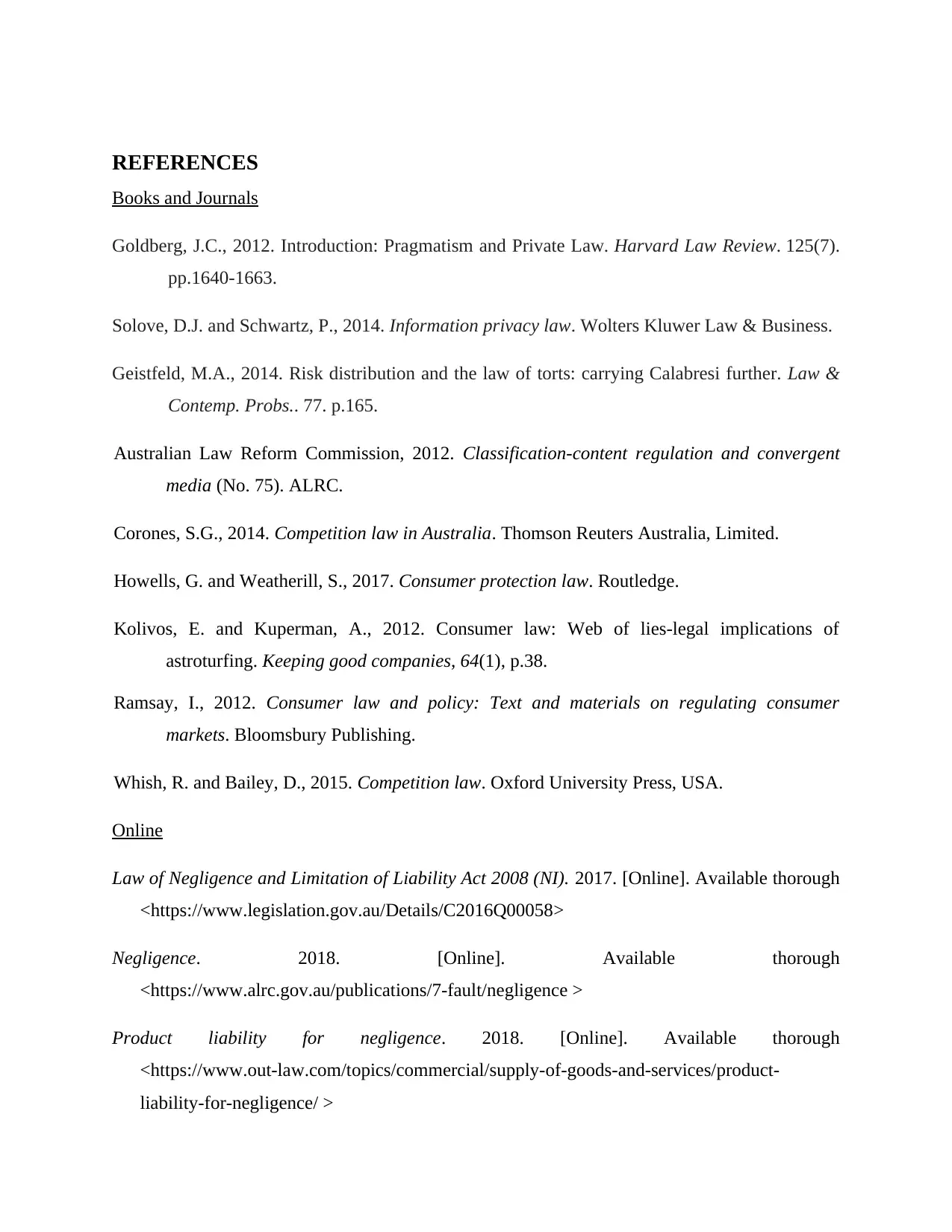
REFERENCES
Books and Journals
Goldberg, J.C., 2012. Introduction: Pragmatism and Private Law. Harvard Law Review. 125(7).
pp.1640-1663.
Solove, D.J. and Schwartz, P., 2014. Information privacy law. Wolters Kluwer Law & Business.
Geistfeld, M.A., 2014. Risk distribution and the law of torts: carrying Calabresi further. Law &
Contemp. Probs.. 77. p.165.
Australian Law Reform Commission, 2012. Classification-content regulation and convergent
media (No. 75). ALRC.
Corones, S.G., 2014. Competition law in Australia. Thomson Reuters Australia, Limited.
Howells, G. and Weatherill, S., 2017. Consumer protection law. Routledge.
Kolivos, E. and Kuperman, A., 2012. Consumer law: Web of lies-legal implications of
astroturfing. Keeping good companies, 64(1), p.38.
Ramsay, I., 2012. Consumer law and policy: Text and materials on regulating consumer
markets. Bloomsbury Publishing.
Whish, R. and Bailey, D., 2015. Competition law. Oxford University Press, USA.
Online
Law of Negligence and Limitation of Liability Act 2008 (NI). 2017. [Online]. Available thorough
<https://www.legislation.gov.au/Details/C2016Q00058>
Negligence. 2018. [Online]. Available thorough
<https://www.alrc.gov.au/publications/7-fault/negligence >
Product liability for negligence. 2018. [Online]. Available thorough
<https://www.out-law.com/topics/commercial/supply-of-goods-and-services/product-
liability-for-negligence/ >
Books and Journals
Goldberg, J.C., 2012. Introduction: Pragmatism and Private Law. Harvard Law Review. 125(7).
pp.1640-1663.
Solove, D.J. and Schwartz, P., 2014. Information privacy law. Wolters Kluwer Law & Business.
Geistfeld, M.A., 2014. Risk distribution and the law of torts: carrying Calabresi further. Law &
Contemp. Probs.. 77. p.165.
Australian Law Reform Commission, 2012. Classification-content regulation and convergent
media (No. 75). ALRC.
Corones, S.G., 2014. Competition law in Australia. Thomson Reuters Australia, Limited.
Howells, G. and Weatherill, S., 2017. Consumer protection law. Routledge.
Kolivos, E. and Kuperman, A., 2012. Consumer law: Web of lies-legal implications of
astroturfing. Keeping good companies, 64(1), p.38.
Ramsay, I., 2012. Consumer law and policy: Text and materials on regulating consumer
markets. Bloomsbury Publishing.
Whish, R. and Bailey, D., 2015. Competition law. Oxford University Press, USA.
Online
Law of Negligence and Limitation of Liability Act 2008 (NI). 2017. [Online]. Available thorough
<https://www.legislation.gov.au/Details/C2016Q00058>
Negligence. 2018. [Online]. Available thorough
<https://www.alrc.gov.au/publications/7-fault/negligence >
Product liability for negligence. 2018. [Online]. Available thorough
<https://www.out-law.com/topics/commercial/supply-of-goods-and-services/product-
liability-for-negligence/ >
⊘ This is a preview!⊘
Do you want full access?
Subscribe today to unlock all pages.

Trusted by 1+ million students worldwide

Proving Fault: What is Negligence?. 2018. [Online]. Available thorough <
https://injury.findlaw.com/accident-injury-law/proving-fault-what-is-negligence.html>
https://injury.findlaw.com/accident-injury-law/proving-fault-what-is-negligence.html>
1 out of 10
Related Documents
Your All-in-One AI-Powered Toolkit for Academic Success.
+13062052269
info@desklib.com
Available 24*7 on WhatsApp / Email
![[object Object]](/_next/static/media/star-bottom.7253800d.svg)
Unlock your academic potential
Copyright © 2020–2025 A2Z Services. All Rights Reserved. Developed and managed by ZUCOL.





